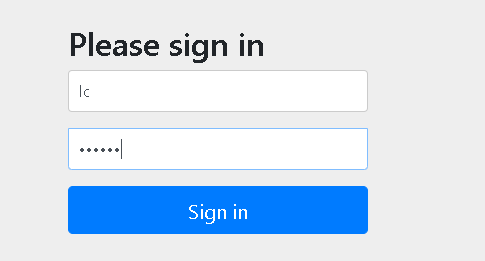简介:
Spring Boot针对Spring Security提供了自动化配置方案,因此可以使Spring Security非常容易地整合进Spring Boot项目中,这也是在Spring Boot项目中使用Spring Security的优势。
1.添加依赖
pom.xml
<dependency> <groupId>org.springframework.boot</groupId> <artifactId>spring-boot-starter-security</artifactId> </dependency> <dependency> <groupId>org.springframework.boot</groupId> <artifactId>spring-boot-starter-web</artifactId> </dependency>
spring-boot-starter-security添加依赖后项目中所有资源都被保护起来了
2/添加hello接口
@RestController public class HelloController { @GetMapping("/hello") public String hello() { String user = methodService.user(); return user; } }
3.启动项目
访问:http://localhost:8080/hello
项目自动跳转到这个由spring security提供的页面

默认用户名user,密码:控制台随机字符串

登陆后:

4.更多:
也可以配置默认的用户名和密码还有用户角色

重启-登陆,可以看到用户名密码等已经被更改


基于内存的认证:
当然,开发者也可以自定义类继承自WebSecurityConfigurerAdapter,进而实现对Spring Security更多的自定义配置,例如基于内存的认证,配置方式如下:

自定义类继承WebSecurityConfigurerAdapter类,重写configure方法,在其中增加了两个用户,配置用户名,密码,角色。
至于加密,使用了NoOpPasswordEncoder即不加密
HttpSecurity
虽然现在可以实现认证功能,但是受保护的资源都是默认的,而且也不能根据实际情况进行角色管理,如果要实现这些功能,就需要重写WebSecurityConfigurerAdapter 中的另一个方法configure,参数可以看到是HttpSecurity.
在第一个configure方法中添加3个角色,root拥有admin和dba,admin拥有admin,user,cc拥有user
在第二个configure方法中,调用authorizeRequests方法开启HttpSecurity配置,
.antMatchers("/admin/**")
.hasRole("ADMIN")
表示访问/admin/路径的必须要admin角色,后面两个也一样道理。
.anyRequest()
.authenticated()
表示除了前面定义的url,后面的都得认证后访问(登陆后访问)
.formLogin()
.loginProcessingUrl("/url")
.permitAll()
表示开启表单登陆,就是一开始看到的登陆界面,登陆url为/login,permitAll表示和登陆相关的接口不需要认证
.csrf()
.disable();
表示关闭csrf(Cross-site request forgery)
@Configuration public class MyWebSecurityConfig extends WebSecurityConfigurerAdapter { @Bean PasswordEncoder passwordEncoder(){ return NoOpPasswordEncoder.getInstance(); } @Override protected void configure(AuthenticationManagerBuilder auth) throws Exception { auth.inMemoryAuthentication() .withUser("root").password("123").roles("ADMIN","DBA") .and() .withUser("admin").password("123").roles("ADMIN","USER") .and() .withUser("cc").password("123").roles("USER"); } @Override protected void configure(HttpSecurity http) throws Exception { http.authorizeRequests() .antMatchers("/admin/**") .hasRole("ADMIN")
.antMatchers("/user/**") .access("hasAnyRole('ADMIN','USER')")
.antMatchers("/db/**") .access("hasAnyRole('ADMIN') and hasRole('DBA')")
.anyRequest() .authenticated() .and()
.formLogin() .loginProcessingUrl("/url") .permitAll() .and()
.csrf() .disable(); } }
在controller:上面的配置,url为/admin/的需要由admin角色,/user/的需要admin或者user都可,/db/的需要admin和dba角色才可以
@GetMapping("/admin/hello")
public String hello2(){
return "admin";
}
@GetMapping("/db/hello")
public String hello3(){
return "db";
}
@GetMapping("/user/hello")
public String hello4(){
return "user";
}
登陆表单详细配置:
迄今为止,登录表单一直使用Spring Security提供的页面,登录成功后也是默认的页面跳转,但是,前后端分离正在成为企业级应用开发的主流,在前后端分离的开发方式中,前后端的数据交互通过JSON进行,这时,登录成功后就不是页面跳转了,而是一段JSON提示。要实现这些功能,只需要继续完善上文的配置,代码如下:
@Configuration public class MyWebSecurityConfig extends WebSecurityConfigurerAdapter { @Bean PasswordEncoder passwordEncoder() { return NoOpPasswordEncoder.getInstance(); } @Override protected void configure(AuthenticationManagerBuilder auth) throws Exception { auth.inMemoryAuthentication() .withUser("root").password("123").roles("ADMIN", "DBA") .and() .withUser("admin").password("123").roles("ADMIN", "USER") .and() .withUser("sang").password("123").roles("USER"); } @Override protected void configure(HttpSecurity http) throws Exception { http.authorizeRequests() .antMatchers("/admin/**") .hasRole("ADMIN") .antMatchers("/user/**") .access("hasAnyRole('ADMIN','USER')") .antMatchers("/db/**") .access("hasRole('ADMIN') and hasRole('DBA')") .anyRequest() .authenticated()
.and() .formLogin() .loginPage("/login_page") //登陆页面 .loginProcessingUrl("/login") //登陆请求处理接口 .usernameParameter("name") //默认用户名,密码 .passwordParameter("passwd")
.successHandler(new AuthenticationSuccessHandler() { //登陆成功后 @Override public void onAuthenticationSuccess(HttpServletRequest req, HttpServletResponse resp, Authentication auth) //当前用户登陆信息 throws IOException { Object principal = auth.getPrincipal(); resp.setContentType("application/json;charset=utf-8"); PrintWriter out = resp.getWriter(); resp.setStatus(200); Map<String, Object> map = new HashMap<>(); map.put("status", 200); map.put("msg", principal); ObjectMapper om = new ObjectMapper(); out.write(om.writeValueAsString(map)); out.flush(); out.close(); } })
.failureHandler(new AuthenticationFailureHandler() { //登陆失败后 @Override public void onAuthenticationFailure(HttpServletRequest req, HttpServletResponse resp, AuthenticationException e) //获取登陆失败原因 throws IOException { resp.setContentType("application/json;charset=utf-8"); PrintWriter out = resp.getWriter(); resp.setStatus(401); Map<String, Object> map = new HashMap<>(); map.put("status", 401); if (e instanceof LockedException) { map.put("msg", "账户被锁定,登录失败!"); } else if (e instanceof BadCredentialsException) { map.put("msg", "账户名或密码输入错误,登录失败!"); } else if (e instanceof DisabledException) { map.put("msg", "账户被禁用,登录失败!"); } else if (e instanceof AccountExpiredException) { map.put("msg", "账户已过期,登录失败!"); } else if (e instanceof CredentialsExpiredException) { map.put("msg", "密码已过期,登录失败!"); } else { map.put("msg", "登录失败!"); } ObjectMapper om = new ObjectMapper(); out.write(om.writeValueAsString(map)); out.flush(); out.close(); } }) .permitAll() .and()
.logout() //开启注销登陆 .logoutUrl("/logout") //注销登陆请求url .clearAuthentication(true) //清除身份信息 .invalidateHttpSession(true) //session失效 .addLogoutHandler(new LogoutHandler() { //注销处理 @Override public void logout(HttpServletRequest req, HttpServletResponse resp, Authentication auth) { } }) .logoutSuccessHandler(new LogoutSuccessHandler() { //注销成功处理 @Override public void onLogoutSuccess(HttpServletRequest req, HttpServletResponse resp, Authentication auth) throws IOException { resp.sendRedirect("/login_page"); //跳转到自定义登陆页面 } }) .and()
.csrf() .disable(); } }
多个HttpSecurity,并且加密,方法安全
配置多个httpSecurity不需要继承WebSecurityConfigurerAdapter,内部类去继承即可,使用@Configuration和@Order注解优先配置
@Configuration
@EnableGlobalMethodSecurity(prePostEnabled = true,securedEnabled = true)
//prePostEnabled=true会解锁@PreAuthorize和@PostAuthorize两个注解,顾名思义,@PreAuthorize注解会在方法执行前进行验证,而@PostAuthorize 注解在方法执行后进行验证。
//securedEnabled=true会解锁@Secured注解。
public class MultiHttpSecurityConfig{ @Bean PasswordEncoder passwordEncoder() { return new BCryptPasswordEncoder(); } @Autowired protected void configure(AuthenticationManagerBuilder auth) throws Exception { auth.inMemoryAuthentication() .withUser("root") .password("$2a$10$RMuFXGQ5AtH4wOvkUqyvuecpqUSeoxZYqilXzbz50dceRsga.WYiq") //密码已经加密 .roles("ADMIN", "DBA") .and() .withUser("admin") .password("$2a$10$RMuFXGQ5AtH4wOvkUqyvuecpqUSeoxZYqilXzbz50dceRsga.WYiq") .roles("ADMIN", "USER") .and() .withUser("sang") .password("$2a$10$eUHbAOMq4bpxTvOVz33LIehLe3fu6NwqC9tdOcxJXEhyZ4simqXTC") .roles("USER"); }
@Configuration @Order(1) public static class AdminSecurityConfig extends WebSecurityConfigurerAdapter{ @Override protected void configure(HttpSecurity http) throws Exception { http.antMatcher("/admin/**").authorizeRequests() //该类配置url为/admin/ .anyRequest().hasRole("ADMIN"); } }
@Configuration public static class OtherSecurityConfig extends WebSecurityConfigurerAdapter{ @Override protected void configure(HttpSecurity http) throws Exception { http.authorizeRequests() .anyRequest().authenticated() .and() .formLogin() .loginProcessingUrl("/login") .permitAll() .and() .csrf() .disable(); } } }
@Service public class MethodService { @Secured("ROLE_ADMIN") //访问此方法需要ADMIN角色 public String admin() { return "hello admin"; } @PreAuthorize("hasRole('ADMIN') and hasRole('DBA')") //访问此方法需要ADMIN且DBA public String dba() { return "hello dba"; } @PreAuthorize("hasAnyRole('ADMIN','DBA','USER')") //三个都行 public String user() { return "user"; } }